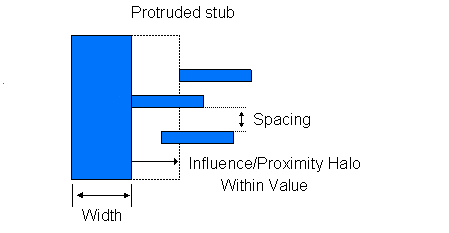 |
 |
 |
||||||
The built-in layer constraint definition oacMinProtrudedProximitySpacing specifies the minimum distance required between a short stub wire (protrusion) and another geometry on the same layer but on a different net, when they are within a certain distance of the wide wire from which the short stub protrudes.
Also known as proximity or influence rules, the spacing required by the protrusion is influenced by the large shape to which it connects. The smaller shape effectively picks up the spacing required by the wider shape.
| Constraint type: | oaLayerConstraint |
| Value types: | oaIntValue, oaInt1DTblValue, oaInt2DTblValue |
| Database types: | oaDesign, oaTech |
| Object types: | oaAppObject |
The following value types are supported by this constraint:
If the oaIntValue is specified, the value represents the minimum spacing in database units required between the protrusion and the small geometry.
Units: DBU
If an oaInt1DTblValue is specified, the lookup key ("width") in the table represents the width of the large influencing shape, and the value for the table represents the minimum spacing required between the protrusion and the small geometry in database units. The width of the shape is defined as the smaller of the shape's two dimensions.
Units: DBU
If an oaInt2DTblValue is specified, the row lookup key ("width") in the table represents the width of the large influencing shape, the column lookup key ("distance") in the table represents the distance between the small shape and the large influencing shape, and the value for the table represents the minimum spacing required between the protrusion and the small geometry in database units.
Units: DBU

The oacMinProtrudedProximitySpacing constraint helps to avoid localized metal density problems caused by placing the large protruded shape close to small shapes, where the small shapes are separated from the protrusion only by the minimum "small shape" spacing requirements.
Copyright 2002 - 2010 Cadence Design Systems, Inc.
All rights reserved.